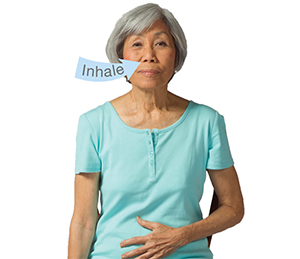Diaphragmatic breathing or belly breathing helps you to breathe with your diaphragm. The diaphragm is a large muscle that plays an important part in breathing. It's located below your lungs. It separates your chest from your belly (abdomen).
With a chronic lung disease, you may use your accessory muscles to breathe instead of your diaphragm. These are a group of muscles in your chest, shoulders, and neck. Using these muscles takes more effort. It also makes shortness of breath worse. Using your diaphragm makes breathing easier. It lets you take in more air. It increases your oxygen level. Try the diaphragmatic breathing exercise below.
Diaphragmatic breathing may help you:
-
Breathe easier
-
Take in more air
-
Relax
-
Exercise or be more active
How to do diaphragmatic breathing
-
Lie on your back with a pillow under your head or sit in a comfortable chair. Make sure your back is supported.
-
Place one hand on your chest and one hand on your belly.
-
Breathe in slowly through your nose. Count to
2 . As you inhale, your belly should move out against your hand. Your chest should stay still. -
Breathe out through your mouth with your lips together. Count to
4 . As you breathe out, you should feel your stomach move in. -
Notice that you breathe in to a count of 2 and that you breathe out to a count of 4. This helps you to keep your breathing slow and steady.
-
Practice this breathing method for 5 to 10 minutes at first. Try to do it 2 to 4 times a day. Then increase the length of time and how often you do it. Start doing this exercise while lying on your back. Then do it while sitting down. Also try it while standing and finally, while doing activities.
As you get more comfortable with this exercise, you can use this type of breathing when:
-
Climbing stairs
-
Taking long walks
-
Showering
-
Carrying or lifting
-
Exercising
-
Doing daily activities
-
Featured in



